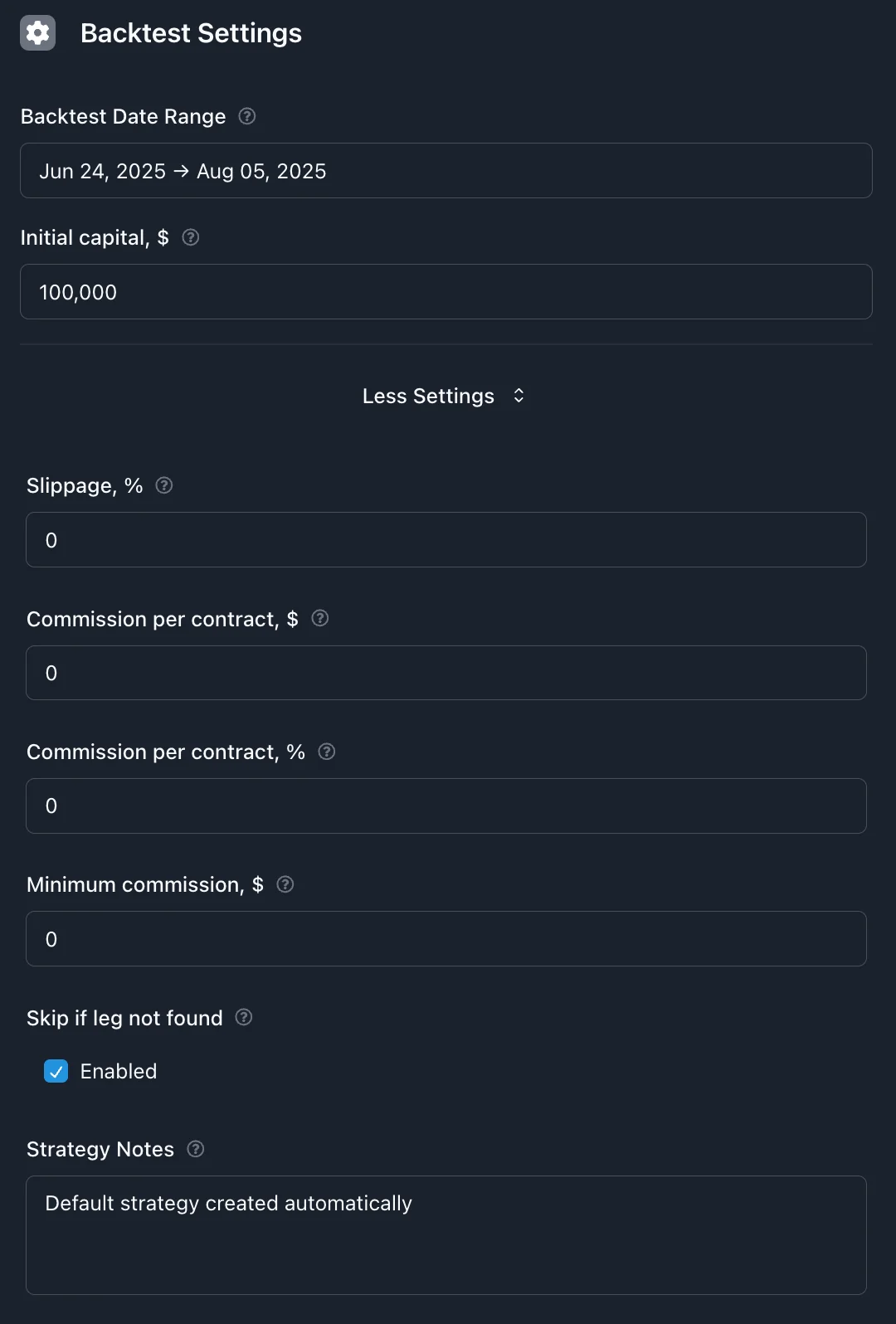Backtest Configuration
Configure capital, costs, and simulation parameters
Backtest Settings
Set up your backtest to simulate how your strategy would have performed with real market data. These settings help make your backtest results as realistic as possible.

Testing Period
Choose the time period you want to test your strategy against. This is when your strategy will be "trading" in the simulation.
Quick Select Presets
Use the Quick Select dropdown to instantly set up common testing periods:
Recent Performance:
- Last 7 days: Very short-term testing
- Last 30 days: Recent month performance
- Month to date: Current month so far
- Year to date: Current year performance
- Last 365 days: Rolling one-year period
- Last 2 years: Two-year rolling window
Market Events & Conditions:
- SPX Daily Expirations: Since May 2022 when daily SPX options launched
- COVID Crash: Feb 20 - Mar 23, 2020 (market crash period)
- 2020-2021 Bull Market: Mar 24, 2020 - Dec 31, 2021 (recovery period)
- Meme Stock Frenzy: January 2021 (GME/AMC volatility)
- Volmageddon: Jan 26 - Feb 28, 2018
How Long Should You Test?
3-6 Months: Quick Testing
- Good for: Testing new ideas quickly
- Benefits: Fast results, easy to iterate
- Limitation: May miss seasonal patterns
1-2 Years: Standard Testing
- Good for: Most strategies
- Benefits: Captures different market conditions
- Recommended: Best balance of thoroughness and speed
3+ Years: Comprehensive Testing
- Good for: Final validation before live trading
- Benefits: Multiple market cycles and volatility periods
- Limitation: Takes longer to run
Starting Capital
Set the amount of money your virtual account starts with. This determines how many contracts you can trade and affects your percentage returns.
Trading Costs
Add realistic trading fees to see how they affect your strategy's profitability. Most brokers charge a fee for each options contract you trade.
Commission Per Contract
This is how much your broker charges for each options contract you buy or sell.
Common Broker Fees:
- Robinhood, Webull: $0.00 (commission-free)
- TD Ameritrade, E*TRADE: $0.65 per contract
- Interactive Brokers: $0.65 per contract (but lower for high volume)
- Traditional Full-Service: 3.00+ per contract
- Open position: 4 contracts × $0.65 = $2.60
- Close position: 4 contracts × $0.65 = $2.60
- Total cost: $5.20 in commissions
Slippage
Slippage accounts for the reality that you rarely get the exact mid-market price when trading. It represents the cost of crossing the bid-ask spread and market impact.
What Slippage Means
When you see an option quoted at $2.00, that might be the mid-price between a $1.95 bid and $2.05 ask. In reality:
- Buying: You'll probably pay closer to $2.05 (or higher)
- Selling: You'll probably receive closer to $1.95 (or lower)
Slippage simulates this real-world trading cost as a percentage of the option premium.
Recommended Slippage Settings
0% - Perfect World
- Assumes you always get mid-market prices
- Unrealistic but useful to see best-case performance
1-2% - Typical Retail Trader
- Realistic for most individual traders
- Recommended starting point: 1.5%
3-5% - Conservative Estimate
- Accounts for poor market conditions or wide spreads
- Good for stress testing your strategy
- Perfect execution: Collect $300
- With slippage: Actually collect $294 ($6 less)
- When closing at 50% profit target: Pay $153 instead of $150
Additional Settings
Skip Missing Options
Recommended: Keep this ON
When your strategy looks for specific options (like a 16-delta put), sometimes those exact options don't exist in the historical data. With this setting enabled:
- ON: Skip the trade entirely if any leg is missing (recommended)
- OFF: Open whatever legs are available (can create unintended positions)
Quick Setup Guide
For Most Strategies
Good starting settings that work for most people:
- Testing Period: 1-2 years of recent data
- Starting Capital: $50,000 (or close to what you'd actually use)
- Commission: Your broker's actual rate (check their website)
- Slippage: 1.5%
- Skip Missing Options: ON
Testing Different Market Conditions
Try these periods to see how your strategy handles different markets:
Bull Market: January 2017 - January 2020
Bear Market: January 2022 - December 2022
High Volatility: March 2020 - December 2020
Low Volatility: January 2017 - December 2017
Common Mistakes to Avoid
- Using perfect execution costs: Real trading has costs
- Testing only good markets: Include volatile and down periods
- Wrong position sizes: Match your actual trading capital
Next Steps
Once you've set up your backtest parameters, you're ready to run your test and analyze the results to see how your strategy performed.